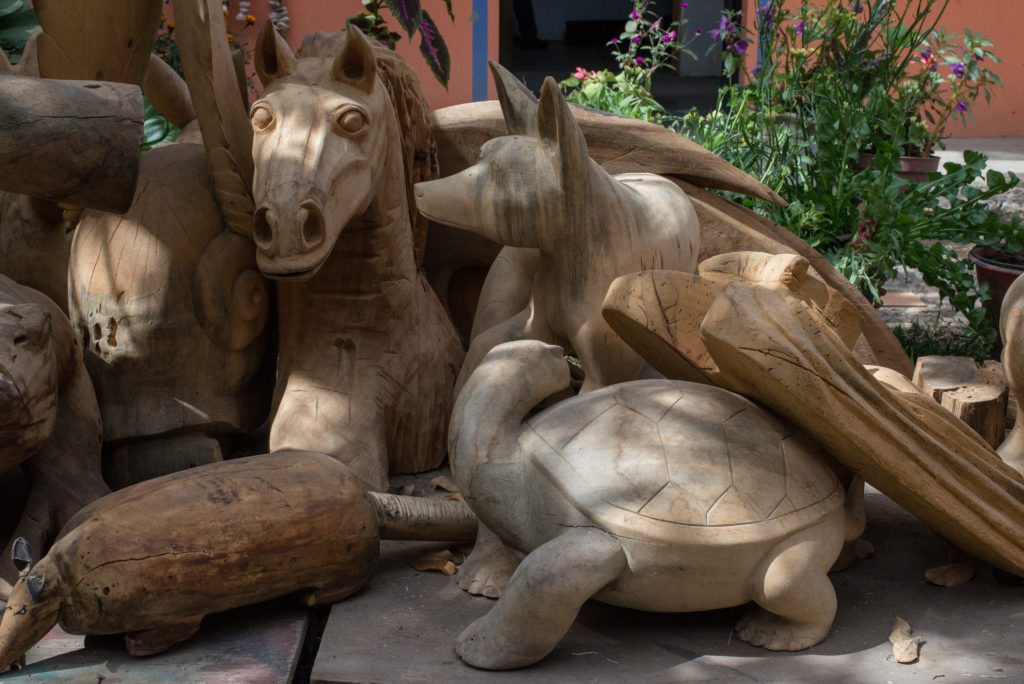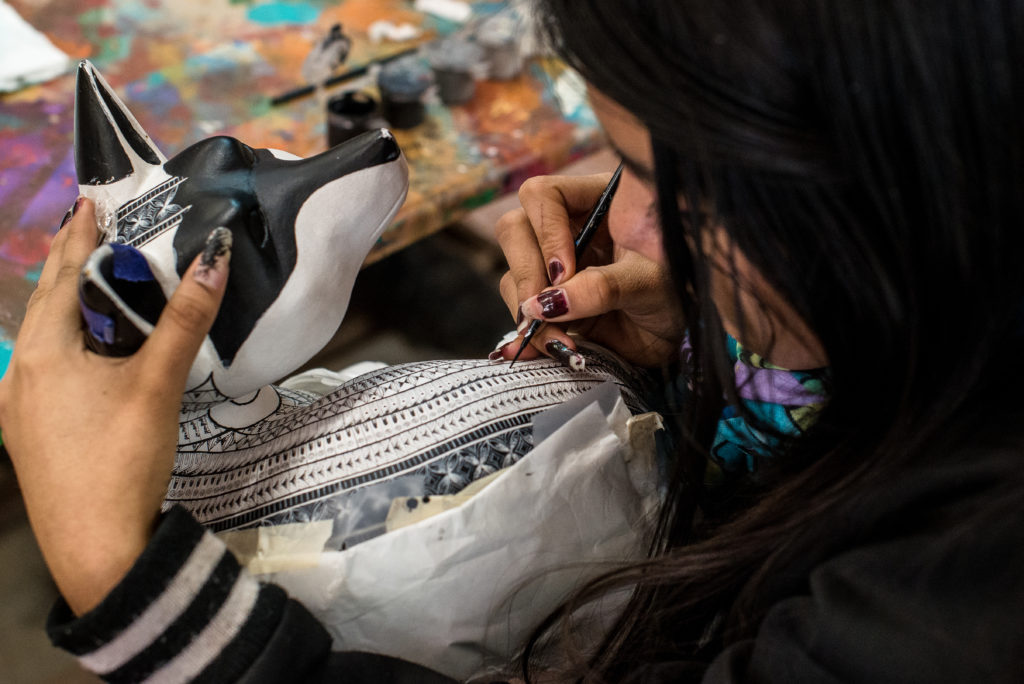One of my priorities while visiting Oaxaca was to get outside the city centro and check out some of the smaller villages and experience what Oaxaca is known for – artisans who make exceptional folk art pieces. I had no expectations but just to visit and perhaps purchase something if it really touched my heart. I walked away with much more.
Jacobo & Maria Angeles in the village of San Martin Tilcajete in the central valley of Oaxaca, Mexico
Besides their amazing art…what impressed me the most is how much value they place on honoring their origins and then educating and teaching in their own community. They are keeping their culture/origins alive by making figurines from carved wood called tonas and nahuales and known worldwide as alebrijes. The tonas are animals of the Zapotec calendar and the nahuales are animals fused with a human being. I’d heard about the Zapotec, but honestly wasn’t that familiar with their background. The Zapotec civilization (a culture dating back 2,500 years) was an indigenous pre-Columbian civilization that flourished in the Valley of Oaxaca. I found the meaning of the symbols used in their artwork so fascinating. I’ll let some of their explanations provide the details of their process.
“The woodcarvers need to study the woodblocks in order to find the hidden natural nahual with their imagination and their skill by using the machete. The nahuales are waiting patiently inside the trees until the artist becomes able to discover them through their senses.”
“By the time the carver finishes the piece, we have an observation and treatment process for keeping the quality of the wood. After that, with the help of creative hands that create vibrant colors and patterns, our zapotec origins start to own the wooden piece.”
“Our raw materials have always been creativity and copal. The copal is a tree of the Burseraceae family. It is considered a sacred tree because from it we obtain not only the wood to carve our sculptures, but also a pigment that will be mixed with natural ingredients such as indigo, cochineal and minerals like limestone and zinc for making a wide range of colors.” (What I admire is that the family has been developing a conservation project of copal trees and other native species of plants for more than 10 years. )
“Our cultural heritage is manifested in the iconography that decorates our pieces. Prehispanic symbology and other designs are part of a unique style that we have developed over the years. The most sincere way in which we can honor and share our zapotec culture is with the pieces we create.”
So much meaning, so much emphasis on their culture…their origin…that’s what went beyond my expectations. And yes, two purchases were made. A tonas – the elephant in the image above accompanied by a certificate of authenticity with several pieces of information…such as it took 9 months to make this piece. Oh, and a small bottle of their artisanal tobala joven – 100% agave mezcal. Salud!






OMG, Robin. No wonder you were completely “taken” by this art form. The elephant you chose gives dignity back to the Elephant we’ve known these past years (sigh). Ironic that it’s what you chose but perhaps a prophetic word for what can be in our lifetimes? Thanks for the link to Jacobo and Maria Angeles. I could stare at their faces forever!
Ha! It never even occurred to me to associate the elephant as you mentioned! But, I certainly see your point! I’ve always loved the elephant from our travels in SE Asia and all the concern over poaching. Plus, it was one that was in my price range as you can imagine these are all quite expensive due to the lengthy process to make them. And I couldn’t agree more…I could stare at those faces forever too….what a beautiful website they’ve put together. Thanks always for checking in! Always enjoy your perspective! xo
What a wonderful post. I absolutely love the cultural history and the hand carved pieces. Love the gorgeous elephant you chose. Each piece is so unique. Working with natural elements give the creations such a beautiful uniqueness.
Thanks for the share.
Oh me too Lisa. That’s what I love about traveling…to learn about culture and then to see how it’s applied to their art. Thank you! xo
I totally missed this post. I am catching up with e-mails and I found this post with absolute fabulous woodcarving/statues/painted animals. That elephant is just fabulous. Don’t you love the serenity to be around people that are so creative that it rubs off on you. Inspire you. It does something with you. It is good that you have these places to go, it keeps you sane and it refills your energy to face the difficult task you have to do concerning your mom. Robin do know that you often are in our minds and we often speak about you. Love and hugs.
Don’t you just love how traveling inspires us? And we both know “traveling” can just mean in our own cities, our own country. But I absolutely get totally revved up learning about other cultures and how this relates to their art. What I so loved about a couple of these visits with the artisans is how they are thinking about, caring about and involving their community. Priceless. And yes, it totally helps to keep me sane in so many ways! Thanks dear!! xoxo
Salud, indeed! What a priceless adventure to find this place and people … wonderful art to learn about.
Thanks Susan! I think about you and Larry all the time when visiting places like this! ❤️
Amazing people. I find it fascinating to hear how the creatures come into existence, they look impressive even without the finishing touches and painting. Isn’t it similar to the art of photography when you open yourself to what is around you and let it speak to you to see what’s inside?